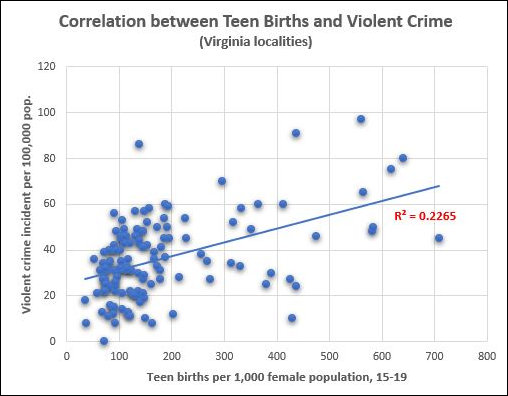I’ll be the first to admit, giving me an Excel spreadsheet is the intellectual equivalent of handing a chimp a machine gun. What I don’t know about statistics would, well… it would fill a statistics textbook. But I abuse statistics less than most journalists, commentators, and politicians, who, to paraphrase renowned economist Ronald H. Coase, routinely torture the data until it confesses. I count on readers to call B.S. when they see it and modify my findings accordingly. In the spirit of exploration and with all due humility, I present the following:
In a previous post, I disputed the conventional wisdom that “poverty” is a “root cause” of violent crime. The lack of income and material resources is undoubtedly a contributing factor, playing into feedback loops of tremendous complexity, but overall the correlation between the poverty rate and the crime rate across Virginia’s 100+ localities is weak — an R² of .1802, which is considered a small effect size. There is a much stronger correlation — an R² of .4007 across Virginia localities, a moderate effect size — between the percentage of single-parent households and violent crime.
If the percentage of single-family households in a population has a moderate influence on crime, I wondered about the percentage of teen births.
Is it possible that young mothers in contemporary society lack the parenting skills and resources to keep their children out of trouble? I crunched the numbers using data from the County Health Rankings and Roadmaps, and the results can be seen above. The verdict: There is an effect, but it is a weak one.
Conservative views of crime place greater emphasis on behavioral issues unrelated to income. In theory, the responsibility of raising a child places a huge stress on a teenager’s life, making it far more difficult to complete high school and find a job. Deferring childbirth until later in life would allow young women to mature, become more employable, and enjoy greater resources, thus better equipping them to control their children’s behavior and/or insulate them from harmful influences.
There may be something to this line of thinking — the R² is higher than that for poverty — but the effect is weak. There is not much to be gained by dwelling on this variable at this stage. Tomorrow, I will address the relationship between a different sign of social dysfunction: sexually transmitted diseases.



